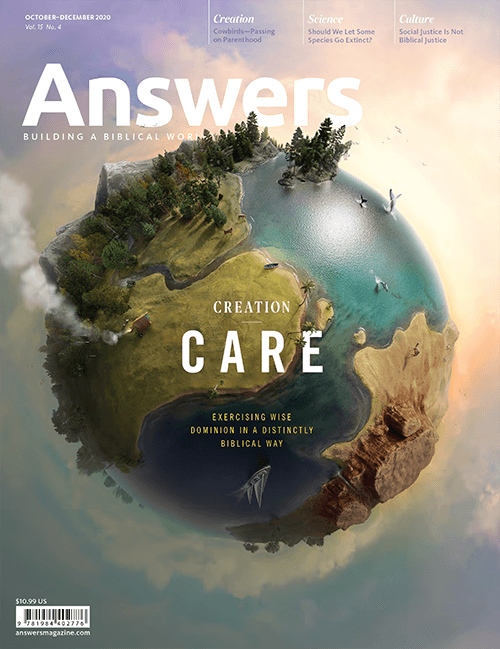Bacteria in Your Home
Experiment from Unlocking Science
Bacteria are everywhere—in air, water, soil, plants, animals, and even inside you! Bacteria are a type of microbe. In 1676 Anton van Leeuwenhoek, a Dutch businessman and scientist, first observed and described bacteria using a microscope. He called the organisms he saw animalcules, meaning “little animals.”
Though the Bible doesn’t mention bacteria, we know God created them most likely on days three, five, and six because they are living organisms. When land was created on day three, free-living bacteria in the soil were likely created along with bacteria for symbiotic (mutually helpful) relationships with plants. Bacteria for symbiotic relationships with swimming and flying creatures were probably created on day five, and bacteria for symbiotic relationships with land animals and humans most likely were brought into existence on day six. It’s also possible that free-living bacteria associated with air and water were created on day two. However, bacteria usually serve as connections between the physical and biological world, so their creation on day two is unlikely since no living things were yet created.
You can’t see bacteria without a microscope—but you can see a colony of bacteria. When hundreds of thousands or millions of individual bacteria grow together, they form colonies, that look like little dots and might be different colors.
Though most are beneficial or harmless, some bacteria can cause disease. That’s why companies have developed antibacterial cleaners claiming to kill bacteria. But what if you put those claims to the test on bacteria around your house?
If you don’t have petri dishes or fancy lab gear, don’t worry. You can perform this experiment in your kitchen. Just be sure not to take a nibble along the way!
Materials Needed
- Plain or unflavored gelatin powder
- Sugar
- Beef bouillon cubes or granules
- Muffin pan and foil muffin cup liners
- Toothpicks
- Permanent marker
- Cotton swabs
- Zipper bags (sandwich size)
Step One—Prepare to Grow the Bacteria
- In a saucepan, mix 4 envelopes of gelatin with 4 cups of cold water, 8 teaspoons of sugar, and 4 bouillon cubes (or 4 teaspoons of bouillon granules).
- Bring slowly to a boil, stirring constantly.
- Cool slightly and fill muffin cup liners (in muffin pans) about 1/3–1/2 full with the hot gelatin.
- Cool until gelatin is solid. Do not touch the surface of the gelatin and do not eat it.
- Place the filled liners in zipper bags and store them in the refrigerator until you’re ready to use them. Be sure to use them within 2 to 3 days.
Step Two—Sample the Surfaces
- Wash your hands thoroughly.
- Without touching the gelatin with your hand, use a toothpick to draw four lines, dividing each gelatin cup into 4 sections. Each section will represent one of the household locations you sample for bacteria.
- On the bottom side of the muffin liners, label each of the 4 sections with a sampling location, such as “kitchen doorknob” and “bathroom sink.” (You’ll need to create duplicates of each gelatin cup because you’ll sample each area again after cleaning the area. Note whether the sections represent the sampling location before or after you’ve cleaned.) Be sure to leave one section of a gelatin cup clean to use as a control to compare with the contaminated gelatin cups.
- For each sampling location, swab a surface in your home that might be frequently handled (for example, stair rails, counters, or the refrigerator door). Then swab gently across the surface of one gelatin section that you’ve marked to correspond with the location.
- Place each muffin liner with gelatin in its own plastic zipper bag but leave a small section unzipped to let in air.
- Clean each sampling location with an antibacterial household cleaner. Wait 15 minutes. Re-swab sampling location (as done in Step 4) onto the second batch of gelatin cups corresponding to the locations. Place all the specimens in a warm location (such as the top of the fridge).
- Count and record the bacteria colonies at 24, 48, and 72 hours. Compare the samplings from before and after the location was cleaned. Do not remove muffin liner from bag and do not touch the gelatin.
- Dispose of the bags and gelatin in muffin liners when the experiment is complete.
What Did You See?
Did you find fewer bacteria colonies after cleaning the surfaces? We can be thankful that God gave us the ingenuity to create products that help protect us against harmful bacteria.
Watch Unlocking Science “Hands On: Culturing Bacteria at Home” on Answers.tv for a demonstration of this experiment.
Answers Magazine
October–December 2020
When it comes to creation care, Christians have a deeper calling than secular environmentalists.
Browse IssueRecommended Resources

Answers in Genesis is an apologetics ministry, dedicated to helping Christians defend their faith and proclaim the good news of Jesus Christ.
- Customer Service 800.778.3390
- Available Monday–Friday | 9 AM–5 PM ET
- © 2025 Answers in Genesis





